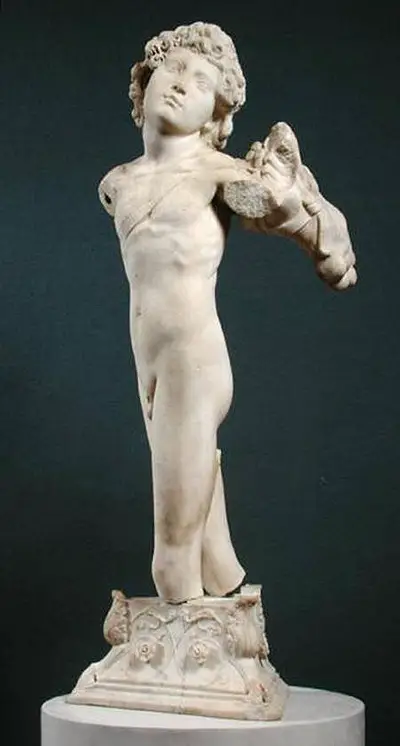The "Manhattan Cupid" - a curly haired boy with damaged limbs and a quiver of arrows made from a lion's paw, stood in the centre of the French Embassy building for French Cultural Services.
It was here in October 1995, that Kathleen Brandt, Professor of Fine Arts at New York University, was attending the opening of an exhibition of French Arts. Under the special lighting for the exhibition, Brandt, an expert in Italian Sculpture, began to realise that the marble sculpture had all the signs that it was the work of a young Michelangelo.
Brandt stated that "all the brilliance coherently fits together in a way only Michelangelo can do". Brant's suspicions rocked the art world but she was determined to track down the sculpture's history and investigate how the statue came to be in the building.
The statue, which appears to date from 1490 would have been one of Michelangelo's early pieces. It was first recorded in 1556 and was situated in a house owned by Jacopo Galli in Rome. Here, the statue is noted as being called "Apollo". By 1650 the figure was recorded as being in a garden at Villa Borgheses in Rome and had been renamed "Cupid". Both Cupid and Apollo are often depicted with bows and arrows but Cupid usually has wings on his back.
This fact is of interest as Galli was a banker to Cardinal Riario who purchased Michelangelo's "fake Sleeping Cupid", a statue which Michelangelo aged by burying it in acidic earth in order to increase its value prior to sale. Although Michelangelo's "fake" was discovered, Riario recognized the young artist's talent and invited him to Rome whereby Michelangelo's reputation and that of his hoax Cupid, grew.
"Sleeping Cupid" was eventually acquired by Charles I of England but it is believed to have been lost in the fire at Whitehall Palace in 1698. No doubt a Cupid statue by Michelangelo would have been a highly valued item at that point in time.
Little appears to be known about the statue of "Standing Cupid" until 1902 when the now damaged figure of Cupid was spotted by a dealer named Stefano Bardini. Bardini identified the statue as Michelangelo's work and took the piece to auction in London. However the statue did not sell and was returned to Rome. It was back in Rome that an architect named Stanford White spotted this statue of a Young Archer, as it is sometimes referred to.
Stanford White was designing a High-Renaissance style house for the Payne Whitney family. He selected the furnishings, paintings and statues for their million dollar house which was built on 5th Avenue. Sadly, Stanford White died before the house was finished but the statue of the Young Archer or Cupid was placed as a focal point in a fountain in the round room or foyer, opposite the main entrance.
Payne Whitney died in 1944. Two years later much of the art was auctioned off but the statue was not sold and remained in situ. In 1952 the house was sold to the French Emabassy yet no-one paid particular attention to the three foot high statue carved in marble with its lower legs and arm missing.
Brandt's reaserch into the statue's history showed that an Italian Scholar named Alessandro Parronchi had identitied the work in 1968 as belonging to Michelangelo too. He had ascertained this from a photograph of the statue in the 1902 auction catalogue. Yet despite Brandt's research, many art experts still found it impossible to believe that a statue by the great Michelangelo had been hiding in plain sight in a house on 5th avenue.
One historian from Columbia University, named James Beck, felt that the statue had been deliberately damaged in order to coverup details that might have proved it was someone's else's work. However, the consus of opinion and research that has been carried out since seems to confirm that Michelangelo did create this sculpture which was found just blocks away from the Metropolitan Museum of Art.
Brandt agrees there has been much damage to the statue and restoration of parts of it has taken place over the years. Yet she is now convinced that the work is that of young Michelangelo. She described how the flick and curls of the young boy's hair and carving techniques were so similar to Michelangelo's early work. She also suggests that the original figure could have been on tiptoe and holding a bow as the figure shows motion.
Another expert, Dr. Penny, a curator for Italian Renaissance in London's National Gallery suggested that no-one, other than Michelangelo, would have been inventive enough to make the boy's quiver out of a lion's paw.
Support for Brandt's theory continued to grow and in December 2012 the Metropolitan Museum of Art, which now holds the statue, dropped the label "attributed" and now just states that the piece was constructed by Michelangelo.
Now that Michelangelo's lost Cupid has been "found" the public's love for the figure has grown but questions about the figure's ownership might still need to be answered.


